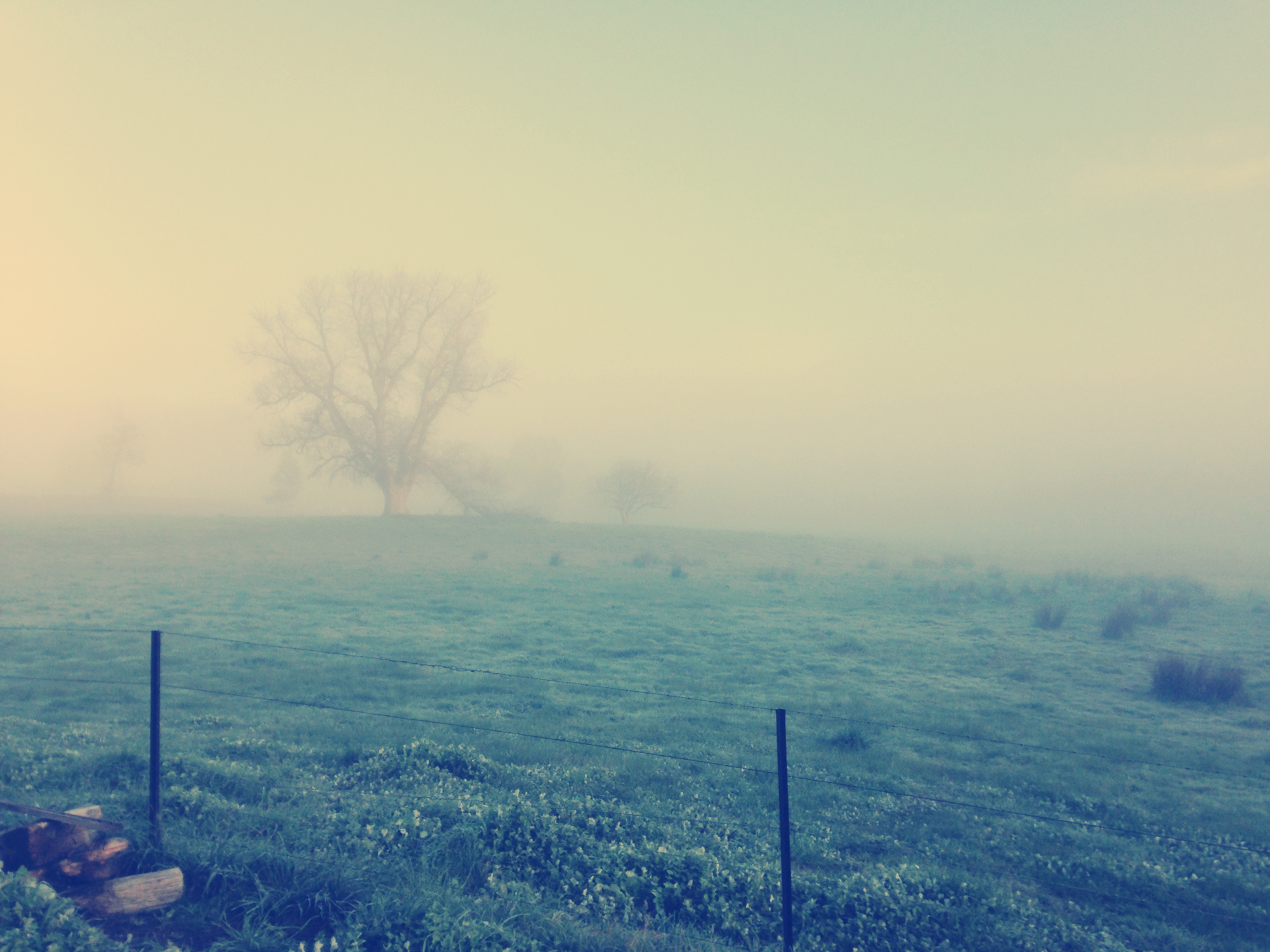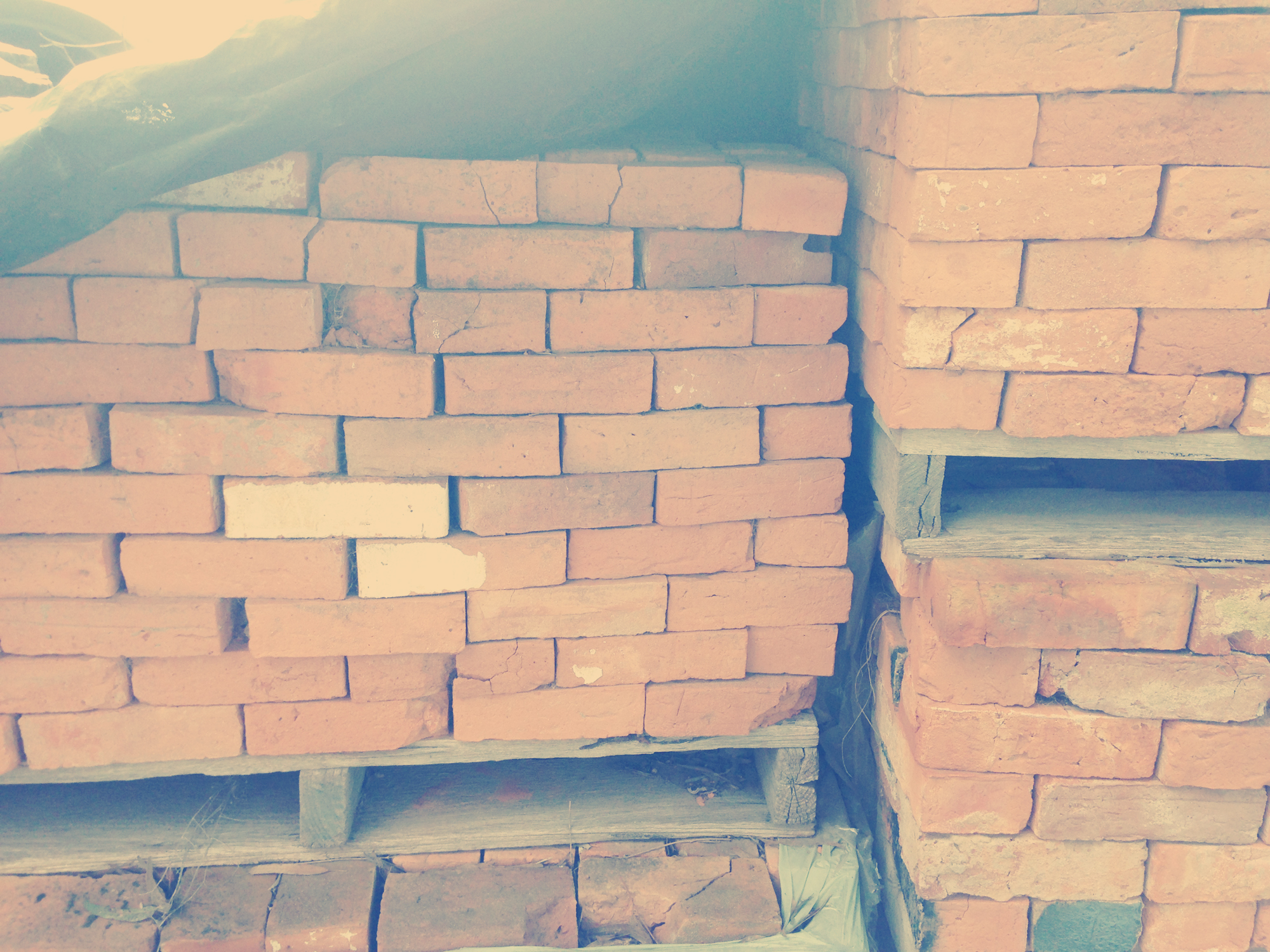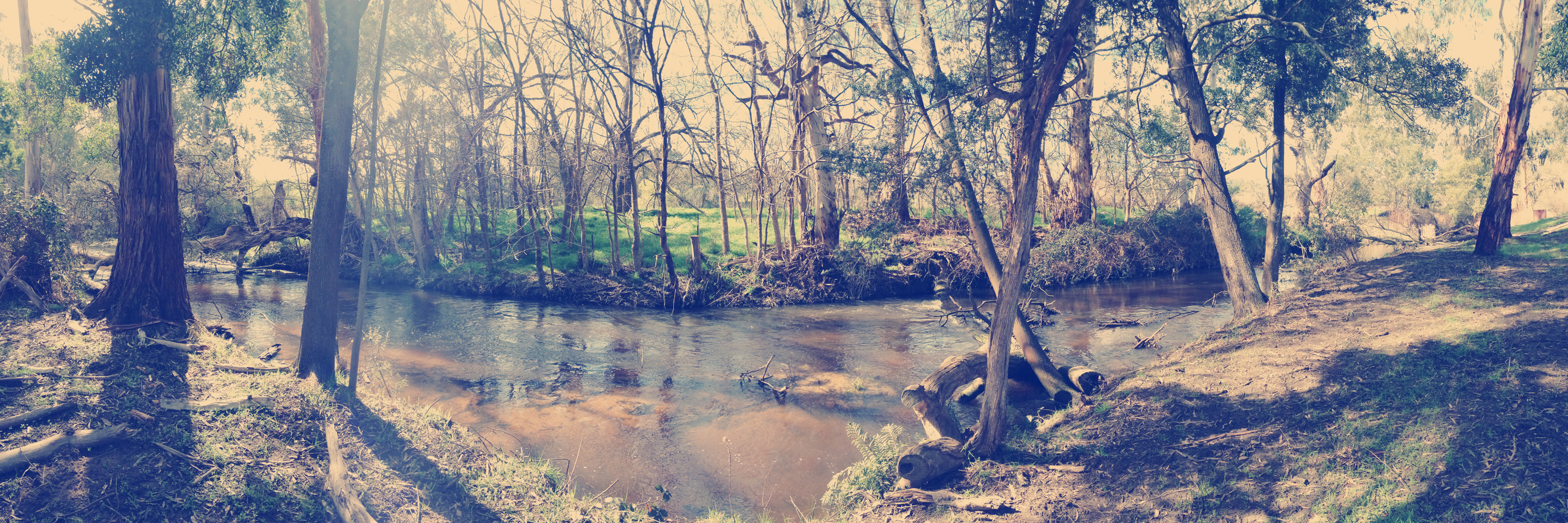Blog | Footsteps of Leplastrier

Day 1
It’s a Sunday lunchtime in late August when we leave Melbourne, giving us plenty of time for a leisurely drive through the Yarra Valley and out to Murrindindi. We’re following in the footsteps of the great architect Richard Leplastrier, who camps out on a site to feel the land and place as he designs. The weather has been wet in recent weeks so we drop into the Croydon Bunnings to buy gumboots. The smell of the sausage stall is too hard to resist, so we pick up snags and munch them happily on our walk back to the car.
As the road opens up along the Melba Highway, we crank the radio and watch the countryside rolling by. The hills get more pronounced the further we drive, and greener too. They look like a giant has dropped a bright green tablecloth onto the ground, the peaks and creases of its fabric forming the ridgelines and valleys of the lush landscape. Everything seems full of life, winter must be losing its grip on the world.
We arrive at the property and meet our clients, David and Louise, and the two youngest of their four children. While the kids fire up their peewee motorbikes, we pull on our boots and head out to explore the land. Nestled at the foot of a valley, the twenty acre property is mostly flat, with vineyard-covered hills rising up towards the south and west. The Murrindindi river gurgles noisily along the eastern boundary, carving a steep embankment and levy on its way out to sea. We stick close to the boundaries during our circumnavigation, enjoying the edge of the tree line. “Ah, the serenity,” we joke as the motorbikes buzz past.

We head back to the shed that will be our sleeping quarters, kitchen, bathroom, lounge and studio during our three-day stay. There used to be a modest weatherboard cottage on site, but it was demolished and cannibalised to convert the wool shed into a temporary place to stay.

The evening sets in, Louise heads back to Melbourne with the kids, and we spread out a 1:1000 copy of the land survey on the dining table. Covering it with yellow trace, we jot down our observations from our walk: the valley funnels the wind so it comes from the north all year round, both hot and cold; there is a long view of mountains to the south; shorter views to the north need landscaping to screen out the closest neighbour; the river offers paddling spots at specific points. We talk about the old house site, and the necklace of mature trees that circle it. In particular, there’s a beautiful Manna gum with a crown at least 18m in diameter. We pop back outside to step it out, “Yep, it’s a whopper.”
Soon, our stomachs remind us they need to be fed so we finish up for the day and head out to the local pub.

Day 2
We wake up to an extraordinary mist blanketing the property. The house site is only 50m away but barely visible. Near the road, a huge Oak looms out of the mist, at once eerie and beautiful. This is why we’re camping here, why Leplastrier’s process is so inspiring. The mist gives us a tiny nugget of insight into the site, helps flesh out our sense of the place.
David cooks up a hearty breakfast of eggs and bacon. After we’ve eaten and are clearing away the dishes, he heads off to mess with a couple of fallen trees. We hear the sound of a chainsaw being fired up. Is there any power tool more rural than a chainsaw?
We pull out the tracing paper again and get to work. Once more, our conversation turns to the land and its opportunities. There’s a wonderful rawness to our dialogue as we sketch and chat. In the suburbs, our primary interests are often manufactured: heritage building fabric; town planning; the needs of neighbours. Here, we discuss place, the relationship between house and land, view corridors, light and shade, trees, habitat. These are the essential qualities of architecture, and a joy to explore.
As we talk, we draw another overlay to our site analysis, highlighting important elements of the landscape and connections we want to make with the house. The distant view to the south is restful, maybe a good fit for guest bedrooms. The river view is more active, the sound of water would make a good backing soundtrack for the kids’ retreat. The light comes from the north of course, how do we elongate the house to make the best use of it?

Before we know it, it’s late morning and we hear a car pulling up. Kate Seddon is the landscape designer we’ve recommended to David and Louise. We’re excited to have her design input on the project, to put as much consideration into the outdoor rooms as the indoor ones. As we’ve only spoken with her over the phone prior to this, her visit is both an opportunity to familiarise her with the site as well as talk design philosophy. We circumnavigate the property once again, and talk about tree species, earthworks, materials and water. Kate spots one of the fallen trees, “That would make a great bench seat within a garden,” she says. We discuss the way we want the house to emerge from the landscape. We discuss the swimming pool and fire pit, outdoor living and family barbecues.

Kate leaves after a couple of hours and we head into town to grab a quick lunch of meat pies and vanilla slice. Then we rendezvous with a local craftsman called Chris, who has some bricks he wants to sell. There are around 18,000 of them stored on pallets. “I pulled these out of the old church on Murrindindi Station when it was demolished years ago,” Chris says. The church dated back to the 1860s, one of the first civic buildings in the area. The bricks are a burnt orange colour, smaller than contemporary ones and curiously don’t have frogs. How can we make use of them? We do some rough calculations – we have enough for 44m of double skinned wall. Not enough for a whole house. We chat about Guilford Bell’s masterly use of brick as an inhabitable surface. Perhaps we’ll use them on the floor instead, or around the fireplace.
Returning to the property, we spend the afternoon focussing on the house site. Its slightly elevated position, existing necklace of mature trees, history of inhabitation and proximity to the river make it the best choice. Glenn Murcutt talks often about putting the house on the worst part of the site – there’s no use putting it on the best part, it’s already perfect. How can we use this to inspire us? Our sketches begin at 1:1000 and meander their way down to 1:200. Everything we draw and say seems to come back to the Manna gum. It’s far too big to wrap a house around, but can we stretch a house along its north edge, or slide one in to the south?
We make a list of the rooms David and Louise have requested in their brief – an open plan living area, plus a connected kids retreat, a master bedroom suite and a handful of extra rooms for kids and guests. Adding a mudroom, laundry and a few bathrooms brings us to around 250sqm. “Don’t forget the wine cellar,” David calls as he walks past on another errand. Okay, 250sqm plus a cellar.
Then there are the qualitative aspects of the brief, our loose conversations with David and Louise in our studio and on site. These are always the most important insights we get into our clients’ lifestyle and aspirations, the nuggets of personality that have the power to drive a whole project. David and Louise live in town, so the Murrindindi house will be an escape from city life, an antidote to the Internet, a place for their children to get comfortable with the natural world. The kids are really getting into the motorbikes, so perhaps the landscape needs to accommodate some natural obstacles. They’ll often have friends over, as will David and Louise, so the kitchen and meals area need to be the heart of the house. The valley traps the heat in summer, so a swimming pool is essential.
We draw bubble diagrams, stringing together rooms in an order that will facilitate these connections both inside the house and out. Distinct functional zones emerge – living, services and sleeping. We chop and change the relationship between rooms, aligning them to different parts of the landscape. We agree that the living room wants to face the sweep of the sun and views to the north. The master bedroom wants to face east to catch sunrise over the river. Do the kids’ and guest bedrooms face west? That might give them views over the neighbouring vineyard but will create heat gain issues. Maybe the south? There’s the long view towards distant mountains, but this is also likely to be the entry point for cars. We’ll need to consider privacy.
We have a lot of ideas, but not yet much resolution. It’s getting dark now however and the pub beckons. A conversation for tomorrow then.

Day 3
In contrast to the chill and mist of yesterday, the day dawns bright and clear. We repeat the rituals of eggs and bacon, quick rinses in the outdoor shower, and a saunter outside to take stock of things. David once again heads off and we get back to the tracing paper.
We sketch plans over and over again, gradually evolving our ideas into three distinct proposals. The cranked house takes shape first, then the long house, and finally the compact house. They each preserve the essential zoning characteristics we settled on yesterday, but offer unique entrance sequences, and unique ways to engage with the glorious Manna gum. It’s hard to work out which we like best. The cranked house has a little of John Wardle about it, with its angled strands and busy junction at the centre. The long house is very long, 55m in fact. “Peter Stutchbury would like this” we say, pleased. It has more than a little of an Indonesian Longhouse about it. The compact house with its sliding walls makes us think of Kerstin Thompson. Is this our chance to finally have a play with breezeblocks?
We like to be open at this early stage of the design process, to encourage our clients to think creatively about the strategic layout of their house and engage meaningfully in its direction. We keep our rough sketches hidden from David for now, but reassure him that all will be revealed when we next meet. We mention Frankenstein’s monster to him, predicting that he and Louise will inevitably like parts of all three houses. “Option four will be better than all three of these,” we say, “It will have your stamp on it as well as ours.”
Once we have the rough dimensions massed in, we duck outside to check our handiwork. We pace out walls, squinting at the space between us as we try to imagine a house sitting there. There’s a dip in natural ground level to the east that would be the perfect spot for a swimming pool to emerge from the ground. With a bit of earthworks, it could be its own pool fence. Are we too close to the Manna gum? What about the old water tower and the Blackwood growing up through it? Can we snake the driveway around it and turn it into a treehouse for the kids?

Ideas fly everywhere, and we rush back to our makeshift studio to scribble them down. Words flow freely and excitedly but are soon forgotten. We need to be careful to capture them all, the little sketches will remind us.
We draw repetitive series of pitched roof forms, simple narrow volumes with lean-tos. We want the house to be humble, connected to the strong Australian heritage of rural construction. There are countless corrugated sheds dotting the landscape, their long forms and gabled roofs powerful inspirations for our own intervention. The house will have its origins in the archetypes of fire pit and tent after all: a place to come together after a day out on the land, and a place to rest in anticipation of tomorrow.
We talk about the bricks, about building fireplaces and fire pits and screens from them. We talk about running them in strips along the floor. We talk about corrugated steel, plywood, timber and glass. Can we do this without structural steel? We like doing magical things with modest materials.
Finally and somewhat reluctantly, we pack up our gear, our sleeping bags and drawing tools. We feel we’ve accomplished more in three days on site than we might have done in three weeks from the studio. Leplastrier clearly knows what he’s talking about.

We head back to Melbourne, our heads full of possibility. We feel we have it all worked out, but at the same time it’s all still up for grabs.
The article first appeared in the December issue of Mezzanine.
Image sources:
- Murrindindi, author’s own image
- Peewee motorbikes, author’s own image
- Campsite, author’s own image
- Morning mist, author’s own image
- Walking the perimeter, author’s own image
- Murrindindi bricks, author’s own image
- Manna gum, author’s own image
- Design sketches, author’s own image
- Murrindindi river, author’s own image